When you start a new job, one of the most important documents you’ll come across is the joining letter. It’s the official confirmation that you have accepted a job offer and are ready to join the organization. A properly written joining letter format creates a positive impression and helps maintain professionalism from day one.
In this blog, we’ll discuss everything you need to know about the joining letter format, including its definition, importance, key elements, writing tips, and ready-to-use samples. Whether you’re an HR professional or a new employee, this guide will help you draft a clear and professional joining letter.
What Is a Joining Letter?
A joining letter is a formal note sent by a candidate to an employer confirming the date of their appointment to the company. It serves as an official acceptance of the job offer and includes important details such as the joining date, position title, and acceptance of the company’s terms and conditions.
In simple terms, a joining letter connects the job offer letter to the actual employment. After receiving the offer letter, the candidate sends back a joining letter to officially confirm their acceptance.
Importance of a Proper Joining Letter Format
A well-structured joining letter format is essential to keeping things professional and clear during the hiring process. It’s not just a formality—it’s a crucial part of any organization’s human resources records and helps both the employer and new employee steer their professional relationship in the right direction.
1. Official Record:
A joining letter is a vital part of a company’s official documentation. It confirms the employee’s acceptance of the job offer, start date, and position, creating a permanent record for the Human Resources department to reference.
2. Reflection of Professionalism:
Submitting a well-structured joining letter demonstrates the employee’s commitment, discipline, and understanding of formal business communication. It leaves a deep impression on the employer and creates a professional atmosphere from day one.
3. Clarity and Transparency:
A clear joining letter includes important details such as the joining date, position, department, and reporting manager. This helps avoid any confusion and ensures that both employer and employee are on the same page on key aspects of the employment.
4. Legal and Compliance Value:
If a dispute arises or verification is required, the joining letter serves as valid proof of the official start date and terms of employment. This protects the interests of both parties.
5. Smooth Onboarding Process:
A thoughtfully crafted joining letter enables the Human Resources department to efficiently plan the onboarding process, prepare the necessary documents, and complete all joining formalities without any interruptions.
In short, following a professional joining letter format not only demonstrates your professionalism but also paves the way for a smooth and organized start in your new role. It’s a small but important step toward embarking on a successful career journey.
Difference Between Offer Letter and Joining Letter
Many people confuse an offer letter with a joining letter, but both serve different purposes.
| Aspect | Offer Letter | Joining Letter |
|---|---|---|
| Purpose | Sent by employer to offer a job. | Sent by the employee to confirm joining. |
| Sender | Employer or HR team. | Employee or candidate. |
| Timing | Before the candidate accepts the job. | After the candidate accepts the offer. |
| Content | Job title, Job designation, salary, and terms of employment. | Acceptance of the job, date of joining, and confirmation |
| Usage | Invitation to join. | Confirmation of joining. |
So, an offer letter is sent first by the company, and a joining letter is sent afterward by the candidate to confirm.
Key Contents of a Good Joining Letter Format
The contents of an Offer Letter may differ from one organization to another, but typically they encompass the following elements:
- Company Information: Information regarding the employer, such as the name of the company, address, and contact details.
- Candidate Information: The name, address, and other relevant personal details of the candidate.
- Position and Job Description: Description of the position being offered, including the job title, duties, and reporting level.
- Compensation: Details about the salary or hourly rate provided, bonuses, commission plans, or other compensation.
- Benefits: Description of the benefits package, such as health insurance, retirement schemes, and other benefits.
- Grades and Conditions: Any conditions or contingencies related to the offer, including background checks, drug screening, or passing other pre-employment testing.
- Start Date: The suggested start date for the candidate’s employment.
- Acceptance Procedure: Instructions to the candidate to accept the offer formally, usually with a response deadline.
How To Write a Good Joining Letter
As per the following step-by-step guide, it is easy to write your joining letter:
Step 1: Mention the Date and Address
Begin by stating the date you are writing the letter, then include the HR’s name and company address.
Step 2: Put a Clear Subject Line
Put a brief and concise subject line such as “Joining Letter for the Post of [Your Job Title].”
Step 3: Greet the Employer Politely
Start with “Dear Sir/Madam” or the HR’s name, if you have it.
Step 4: State Your Acceptance
Clearly indicate that you are accepting the offer and give your joining date.
Step 5: Include Designation and Department
Include your designation and department to clarify.
Step 6: Be Thankful
Thank them for the chance and show enthusiasm to join the firm.
Step 7: Close Professionally
End the letter with “Yours faithfully” or “Yours sincerely,” and your name and contact number.
By following these steps, you can easily create a clean and professional joining letter format for any organization.
Sample Joining Letter Format (General Template)
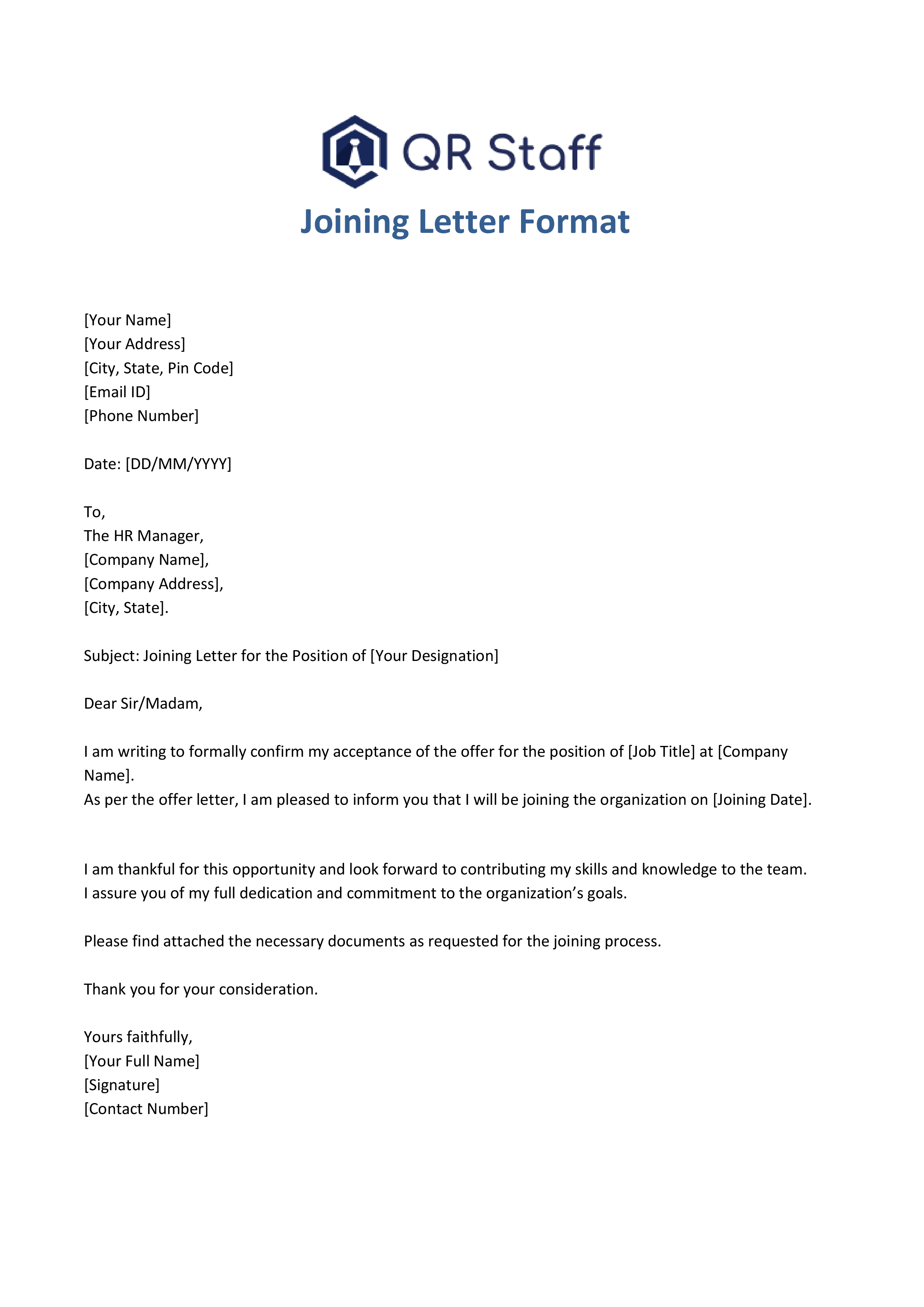
Download Joining Letter Formats
Looking for a ready-to-use Joining Letter Format?
Download the professional and editable templates below — perfect for freshers, experienced professionals, and HR departments.
These templates are clean, professional, and easy to customize with your details — including name, designation, and joining date. You can use them directly for official submissions or HR onboarding.
Joining Letter Format for Freshers
If you’re just starting out in your first job, it’s a good idea to keep your joining letter simple and polite.
Example:

Joining Letter Format for Experienced Employees
For those with more experience, a more formal and confident tone works best.
Example:
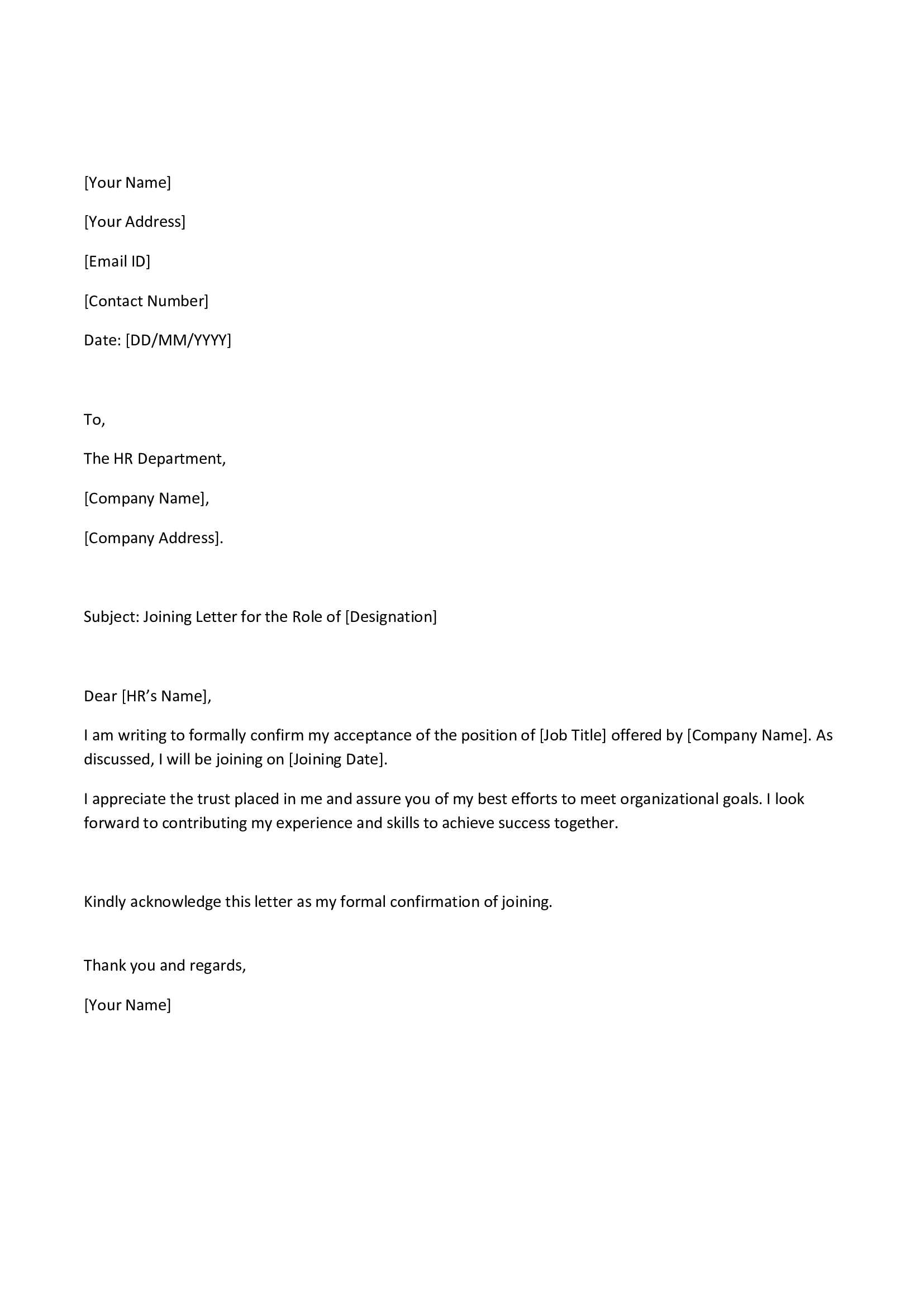
Joining Letter Format for Government Job
When it comes to government job joining letters, they usually stick to a specific structure and maintain a formal tone.
Example:
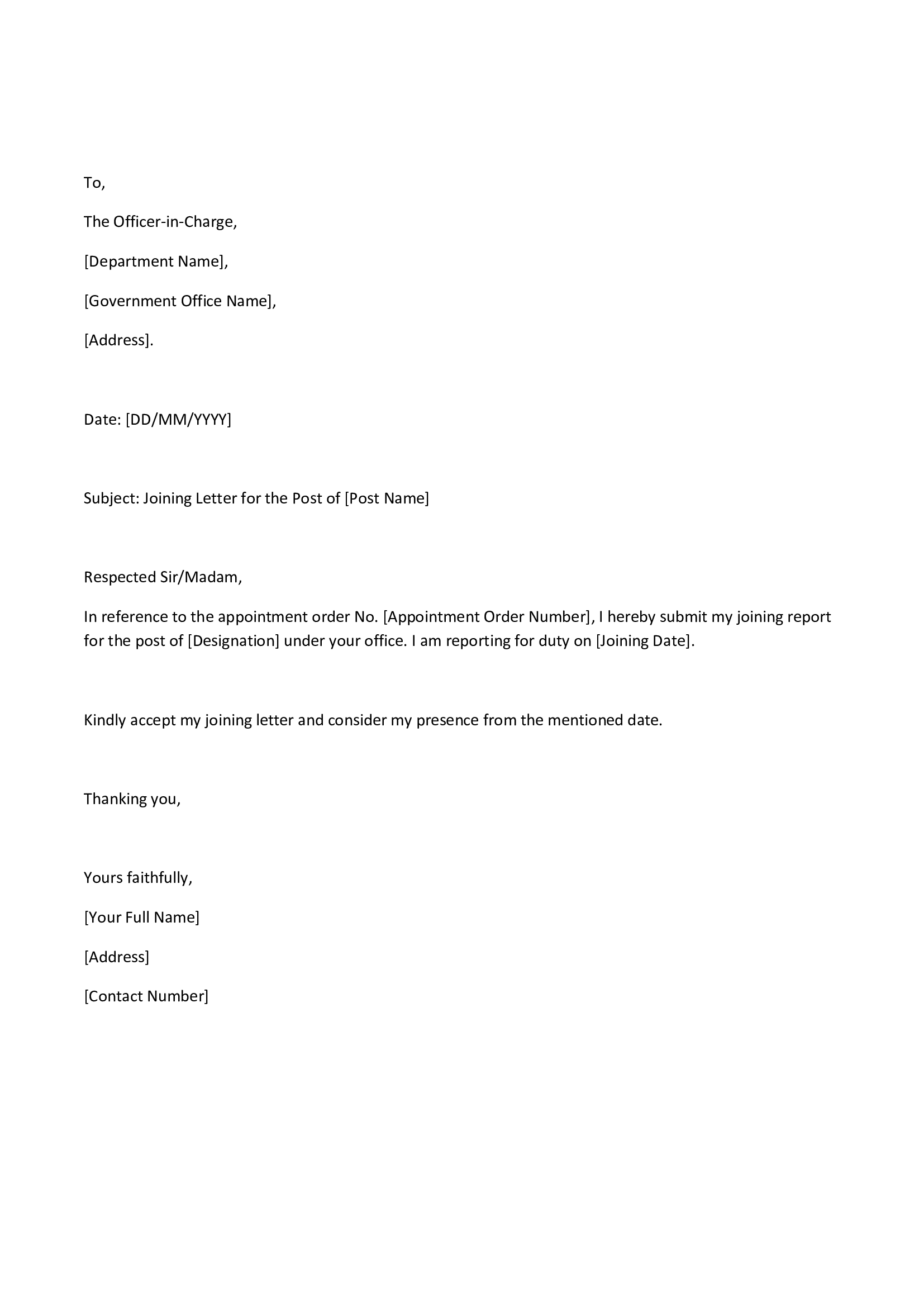
Email Format for Joining Letter
These days, many companies are open to receiving joining letters via email, especially for remote or hybrid positions.
Example:
Subject: Joining Letter – [Your Name], [Designation]
Email Body:
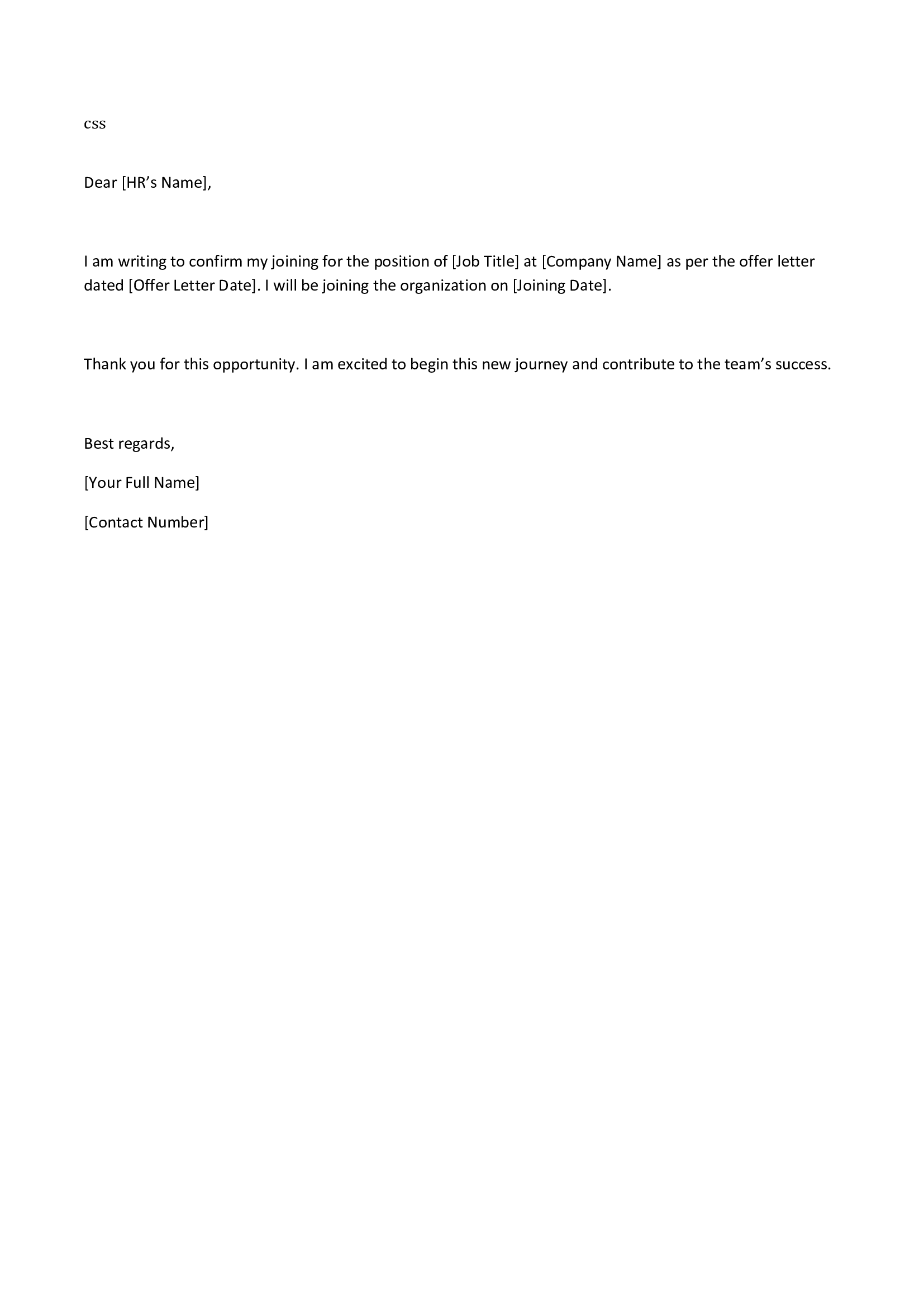
Tips to Write a Perfect Joining Letter
Crafting a solid joining letter format is all about striking the right balance between clarity and professionalism. Here are some handy tips to guide you:
- Keep it concise: Stick to the essentials and avoid any fluff.
- Use courteous language: Maintain a respectful and formal tone throughout your letter.
- Double-check your details: Ensure the job title, joining date, and company name are all accurate.
- Watch for typos: Give it a thorough proofread before sending.
- Stick to proper formatting: Choose professional fonts and ensure your spacing is on point.
- Include necessary documents: If HR has asked for them, don’t forget to attach any required certificates or ID proofs.
- Save a copy: Keep both a digital and a printed version for your records.
By following these tips, you’ll create a joining letter that not only looks professional but also makes a lasting impression.
Common Mistakes to Avoid in a Joining Letter
Even the tiniest mistakes can lead to confusion or delays during your onboarding process. To ensure your joining letter is spot on, steer clear of these common pitfalls:
– Leaving out a clear or complete joining date.
– Forgetting to include your job title or department.
– Using overly casual or informal language.
– Neglecting to express gratitude to the employer for the opportunity. – Submitting the letter after the deadline.
– Sending the wrong file name or format in your email.
By avoiding these errors, you’ll make your joining letter both clear and professional!
Sample of Short Joining Letter Format
If the company only needs a short confirmation, use this concise version:

Joining Letter Format for Internship
If you are joining as an intern, here’s a sample you can use:

In Conclusion
A well-crafted joining letter format really sets the stage for your professional journey. It not only confirms your commitment but also clarifies key details and helps ensure a smooth onboarding experience. Whether you’re a fresh graduate, a seasoned professional, or stepping into a government role, sticking to the right joining letter format is crucial. Always keep your letter straightforward, formal, and free of errors.
Feel free to tweak the samples provided in this article to fit your company’s specific needs.
If your organization is looking for automated HR and staff management solutions, check out QR Staff – a smart attendance and payroll management app. It’s designed to simplify attendance, leave, and salary processes for businesses of all sizes.
frequently asked questions (FAQs)
1. What’s the difference between an offer letter and a joining letter?
An offer letter is what the employer sends to propose a job, while a joining letter is sent by the employee to confirm their acceptance of the job and the date they’ll start. The offer letter comes first, and then the joining letter follows.
2. What details should I include in a joining letter format?
A well-structured joining letter should have:
– Date of submission
– Employer’s name and company details
– Subject line
– Joining date and job title
– A brief acceptance message
– A note of thanks and your signature
3. How do I write a joining letter as a fresher?
As a fresher, keep your joining letter straightforward and courteous. Include your job title, joining date, and express your gratitude for the opportunity. Stick to concise sentences and use formal language.
4. Should I attach documents with my joining letter?
If the HR team asks for it, feel free to attach documents like your ID proof, educational certificates, or experience letters along with your joining letter for verification.
5. Where can I download a professional Appointment Letter Format in Word?
You can easily download a professional Appointment Letter Format in Word from our detailed guide on this topic. The blog includes ready-to-use editable templates for different job roles and industries, making it simple to customize as per your company’s needs.
Download Appointment Letter Format in Word
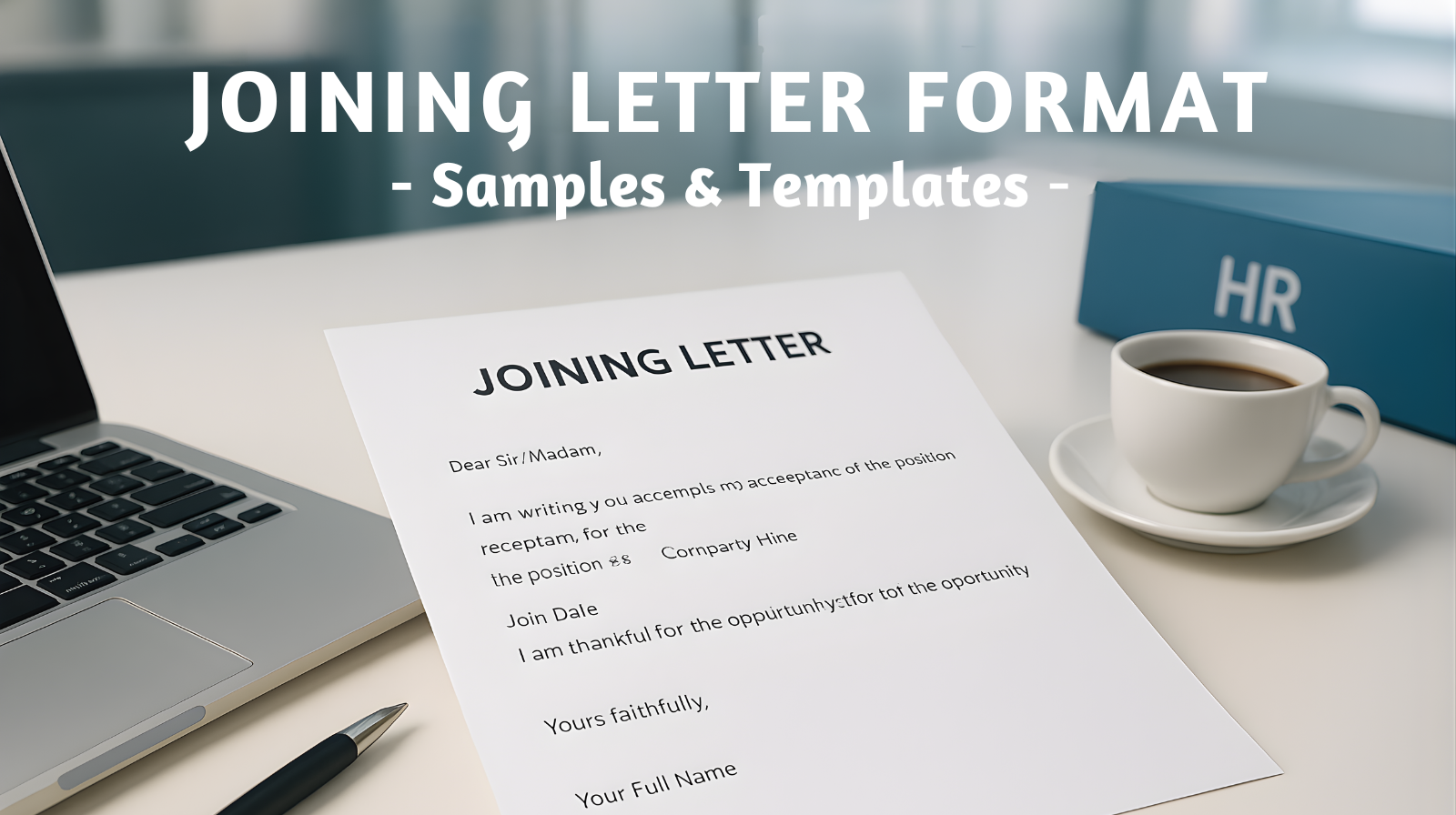
Leave a Reply